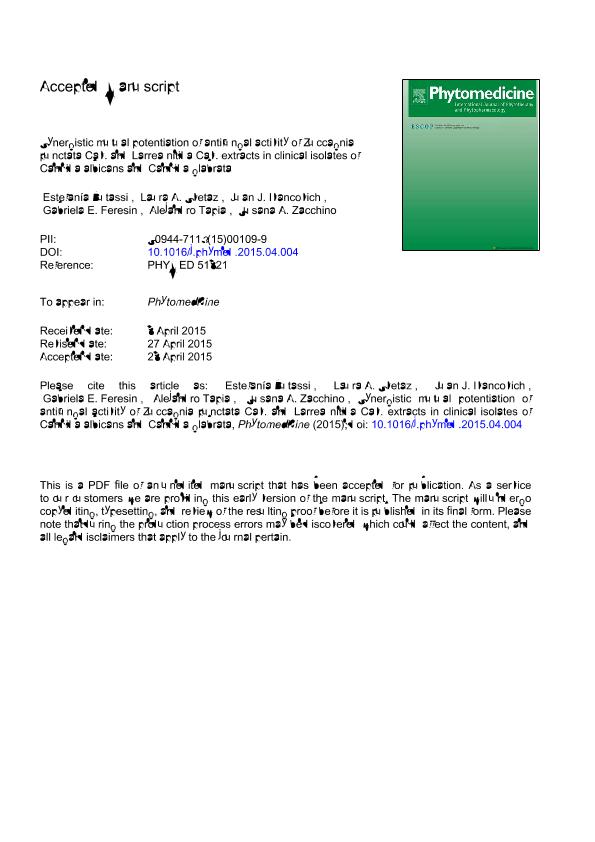Mostrar el registro sencillo del ítem
dc.contributor.author
Butassi, Estefanía

dc.contributor.author
Svetaz, Laura Andrea

dc.contributor.author
Ivancovich, Juan J.
dc.contributor.author
Feresin, Gabriela Egly

dc.contributor.author
Tapia, Alejandro A.
dc.contributor.author
Zacchino, Susana Alicia Stella

dc.date.available
2018-04-20T16:49:50Z
dc.date.issued
2015-05
dc.identifier.citation
Butassi, Estefanía; Svetaz, Laura Andrea; Ivancovich, Juan J.; Feresin, Gabriela Egly; Tapia, Alejandro A.; et al.; Synergistic mutual potentiation of antifungal activity of Zuccagnia punctata Cav. and Larrea nitida Cav. extracts in clinical isolates of Candida albicans and Candida glabrata; Elsevier Gmbh; Phytomedicine; 22; 6; 5-2015; 666-678
dc.identifier.issn
0944-7113
dc.identifier.uri
http://hdl.handle.net/11336/42833
dc.description.abstract
Background: Zuccagnia punctata Cav. (Fabaceae) and Larrea nitida Cav. (Zygophyllaceae) are indistinctly or jointly used in traditional medicine for the treatment of fungal-related infections. Although their dichloromethane (DCM) extract have demonstrated moderate antifungal activities when tested on their own, antifungal properties of combinations of both plants have not been assessed previously. Purpose: The aim of this study was to establish with statistical rigor whether Z. punctata (ZpE) and L. nitida DCM extract (LnE) interact synergistically against the clinically important fungi Candida albicans and Candida glabrata and to characterize the most synergistic combinations. Study design: For synergism assessment, the statistical-based Boik's design was applied. Eight ZpE–LnE fixed-ratio mixtures were prepared from four different months of 1 year and tested against Candida strains. Lϕ (Loewe index) of each mixture at different fractions affected (ϕ) allowed for the finding of the most synergistic combinations, which were characterized by HPLC fingerprint and by the quantitation of the selected marker compounds. Methods: Lϕ and confidence intervals were determined in vitro with the MixLow method, once the estimated parameters from the dose–response curves of independent extracts and mixtures, were obtained. Markers (four flavonoids for ZpE and three lignans for LnE) were quantified in each extract and their combinations, with a valid HPLC–UV method. The 3D-HPLC profiles of the most synergistic mixtures were obtained by HPLC–DAD. Results: Three over four IC50ZpE/IC50LnE fixed-ratio mixtures displayed synergistic interactions at effect levels ϕ > 0.5 against C. albicans. The dosis of the most synergistic (Lϕ = 0.62) mixture was 65.96 µg/ml (ZpE = 28%; LnE = 72%) containing 8 and 36% of flavonoids and lignans respectively. On the other hand, one over four IC50ZpE/IC50LnE mixtures displays synergistic interactions at ϕ > 0.5 against C. glabrata. The dosis of the most synergistic (Lϕ = 0.67) mixture was 168.23 µg/ml (ZpE = 27%; LnE = 73%) with 9.7 and 31.6% of flavonoids and lignans respectively. Conclusions: Studies with the statistical-based MixLow method, allowed for the finding of the most ZpE–LnE synergistic mixtures, giving support to a proper joint use of both antifungal herbs in traditional medicine.
dc.format
application/pdf
dc.language.iso
eng
dc.publisher
Elsevier Gmbh

dc.rights
info:eu-repo/semantics/openAccess
dc.rights.uri
https://creativecommons.org/licenses/by-nc-nd/2.5/ar/
dc.subject
Zuccagnia Punctata
dc.subject
Larrea Nitida
dc.subject
Bi-Herbal Combinations
dc.subject
Synergism
dc.subject
Antifungal
dc.subject
Mixlow Method
dc.subject.classification
Otras Ciencias Químicas

dc.subject.classification
Ciencias Químicas

dc.subject.classification
CIENCIAS NATURALES Y EXACTAS

dc.title
Synergistic mutual potentiation of antifungal activity of Zuccagnia punctata Cav. and Larrea nitida Cav. extracts in clinical isolates of Candida albicans and Candida glabrata
dc.type
info:eu-repo/semantics/article
dc.type
info:ar-repo/semantics/artículo
dc.type
info:eu-repo/semantics/publishedVersion
dc.date.updated
2018-04-10T17:48:54Z
dc.journal.volume
22
dc.journal.number
6
dc.journal.pagination
666-678
dc.journal.pais
Alemania

dc.journal.ciudad
Berlín
dc.description.fil
Fil: Butassi, Estefanía. Universidad Nacional de Rosario. Facultad de Ciencias Bioquímicas y Farmacéuticas; Argentina. Consejo Nacional de Investigaciones Científicas y Técnicas; Argentina
dc.description.fil
Fil: Svetaz, Laura Andrea. Universidad Nacional de Rosario. Facultad de Ciencias Bioquímicas y Farmacéuticas; Argentina. Consejo Nacional de Investigaciones Científicas y Técnicas; Argentina
dc.description.fil
Fil: Ivancovich, Juan J.. Universidad Nacional de Rosario. Facultad de Ciencias Bioquímicas y Farmacéuticas; Argentina
dc.description.fil
Fil: Feresin, Gabriela Egly. Universidad Nacional de San Juan. Facultad de Ingeniería. Instituto de Biotecnología; Argentina. Consejo Nacional de Investigaciones Científicas y Técnicas; Argentina
dc.description.fil
Fil: Tapia, Alejandro A.. Universidad Nacional de San Juan. Facultad de Ingeniería. Instituto de Biotecnología; Argentina
dc.description.fil
Fil: Zacchino, Susana Alicia Stella. Universidad Nacional de Rosario. Facultad de Ciencias Bioquímicas y Farmacéuticas; Argentina. Consejo Nacional de Investigaciones Científicas y Técnicas; Argentina
dc.journal.title
Phytomedicine

dc.relation.alternativeid
info:eu-repo/semantics/altIdentifier/doi/http://dx.doi.org/10.1016/j.phymed.2015.04.004
dc.relation.alternativeid
info:eu-repo/semantics/altIdentifier/url/https://www.sciencedirect.com/science/article/pii/S0944711315001099
Archivos asociados
